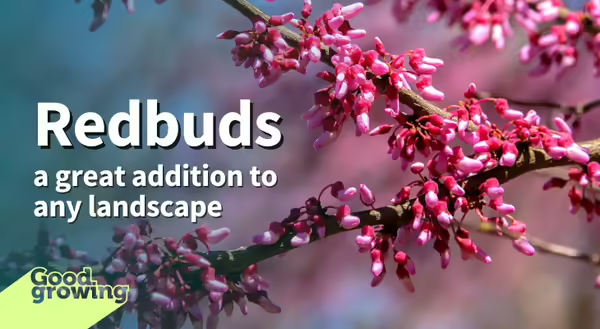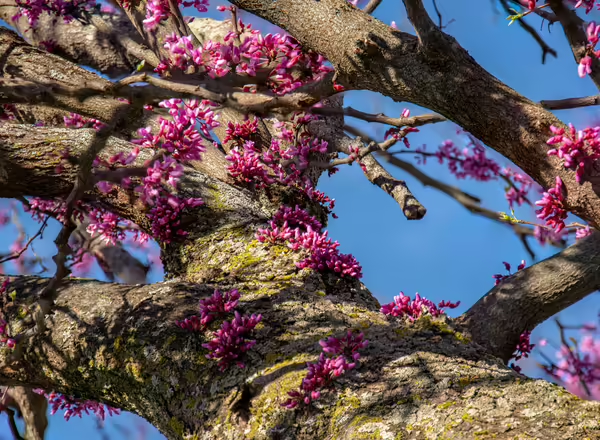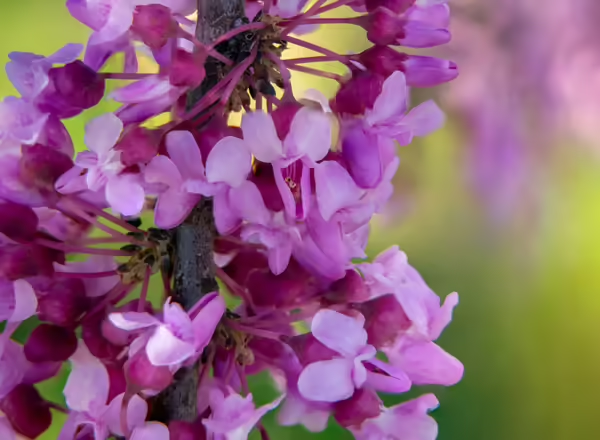
While spring-blooming bulbs get much of our attention in the spring, flowering trees shouldn’t be overlooked. One of the best trees for spring color is the adaptable eastern redbud (Cercis canadensis). Flowering redbuds are a sure sign that spring has arrived.
What do they look like?
Eastern redbuds are small (20-30 feet tall) trees with short trunks and spreading branches forming a flat-topped or rounded crown (20-30 feet wide). They may also grow as a multi-trunked tree or shrub. When young, redbuds grow moderately fast, reaching 7 – 10 feet tall in five to six years. As the trees mature, their growth slows.
Redbuds are among the earliest trees to bloom in the spring. The pink to reddish-purple pea-like flowers develop in clusters along the branches and even occasionally on the trunks of trees (cauliflory). The flowers are produced before their leaves emerge and last for several weeks. After flowering begins, the heart-shaped leaves will start to emerge. At first, leaves are reddish but will become dark green as they mature.
After being pollinated, flowers will produce green, 3-inch-long seed pods that resemble peas. As the seed pods mature, they will turn brown and can contain up to 12 seeds. The seedpods will often remain on the tree into winter.
In addition to their colorful spring floral display, redbuds can also provide some ornamental interest in the fall with their yellow leaves, although the color isn’t reliable. The bark of trees is smooth and brown when young. As they age, it becomes dark brown to gray, ridged, and scaly. Rust-colored patches can also be seen as scales slough off the trees.



More than ornamental appeal
In addition to their ornamental appeal, redbuds also provide value to wildlife. Due to their early blooming, they can be important food sources for early-season pollinators such as bumble bees and carpenter bees. Leaf-cutter bees will cut sections out of the plants' leaves to help build their nests.
While they may not host as many species of butterflies and moths as oaks, several species of butterflies and moths will utilize redbuds as a larval food source, including the white flannel moth, Henry's elfin, American dagger moth, and io moth.
The seeds of redbuds may also act as a food source. Birds, such as cardinals, rose-breasted grosbeaks, and bobwhites, as well as squirrels, will feed on the seeds.
The flowers of redbuds are also edible. The flowers can be eaten fresh (taste similar to peas), added as a garnish to salads, pickled, fried, and used to make jelly.
Growing and caring for redbuds
Because of their relatively small size and prolific spring blooming, eastern redbuds are an excellent addition to nearly any landscape. They are native to Illinois and much of the eastern United States and are hardy from zones 5-9 (a few cultivars are hardy to zone 4). They grow best in full sun but can tolerate partial shade (flowering will be reduced) and will tolerate a wide range of soils as long as they are well-drained (they don't like 'wet feet').
Despite their appeal, redbuds aren't without problems. They can be difficult to transplant, so it is best to plant younger trees. When purchasing trees, try to make sure that the plant material comes from the Midwest (or other colder locations). Because redbuds have such a wide host range, their cold sensitivity can vary, and plant material from warmer, southern areas may not do well during our cold winters.
Unfortunately, redbuds aren't particularly long-lived, especially when stressed. Healthy trees often only live for 50-75 years. Stressed trees and those infected by pathogens, like Botryosphaeria canker and Verticillium wilt, have shorter life spans.
Redbud cultivars
Redbuds have become increasingly popular plants in our landscapes. Because of this increased interest, many new cultivars have been developed, and there are now over 60 named cultivars (up from 29 in 1980) with a variety of different traits.
- White flowers such as 'Alba' and 'Royal White'
- Variegated foliage like 'Alley Cat' and 'Floating Clouds'
- Purple foliage, which may fade to green in hot weather
- 'Black Pearl' also has more compact growth than the species, growing 15 to 20 feet tall
- 'Forest Pansy' was the first cultivar with purple foliage (1947), but is less cold hardy than the species (zone 6)
- Yellow foliage (which will eventually turn green)
- 'Hearts of Gold' is also shorter than the species, growing to 15 feet tall
- The Rising Sun' JN2' new growth emerges golden-orange, then turns yellow, and eventually green; it is also shorter than the species, growing to 8 to 12 feet tall
- Weeping habit
- 'Ruby Falls' also has purple leaves that turn bronzy green and grow to 6 to 8 feet tall
- 'Vanilla Twist' also has white flowers
- Compact habit
- 'Ace of Hearts' grows to be 10 to 15 feet tall with smaller leaves (that also overlap) and flowers than the species
- 'Little Woody' grows to be 10-15 feet tall
Good Growing Fact of the Week: Unlike many plants in the pea/legume family (Fabaceae), redbuds don't fix nitrogen from the atmosphere because their roots lack the nodules that contain nitrogen-fixing bacteria (rhizobia).
Resources and for more information
Dickson, James G. "Eastern Redbud." Cercis canadensis L. USDA Forest Service, Southern Research Station. Accessed April 7, 2023. https://www.srs.fs.usda.gov/pubs/misc/ag_654/volume_2/cercis/canadensis.htm.
Dirr, Michael A. Dirr's Encyclopedia of Trees and Shrubs. Portland: Timber Press, 2017.
Dirr, Michael A., and Keith S. Warren. The Tree Book: Superior Selections for Landscapes, Streetscapes, and Gardens. Portland, OR: Timber Press, 2019.
Kidwell-Slak, David L., and Margaret R. Pooler. "A Checklist of Cercis (Redbud) Cultivars." HortScience 53, no. 2 (2018): 148–52. https://doi.org/10.21273/hortsci12564-17.
Robertson, K. R. 1976. Cercis: The redbuds. Arnoldia, 36(2): 37–49
Signup for our emails! Want to get notified when new Good Growing posts are available? SIGN ME UP
MEET THE AUTHOR
Ken Johnson is a Horticulture Educator with University of Illinois Extension, serving Calhoun, Cass, Greene, Morgan, and Scott counties since 2013. Ken provides horticulture programming with an emphasis on fruit and vegetable production, pest management, and beneficial insects. Through his programming, he aims to increase backyard food production and foster a greater appreciation of insects.